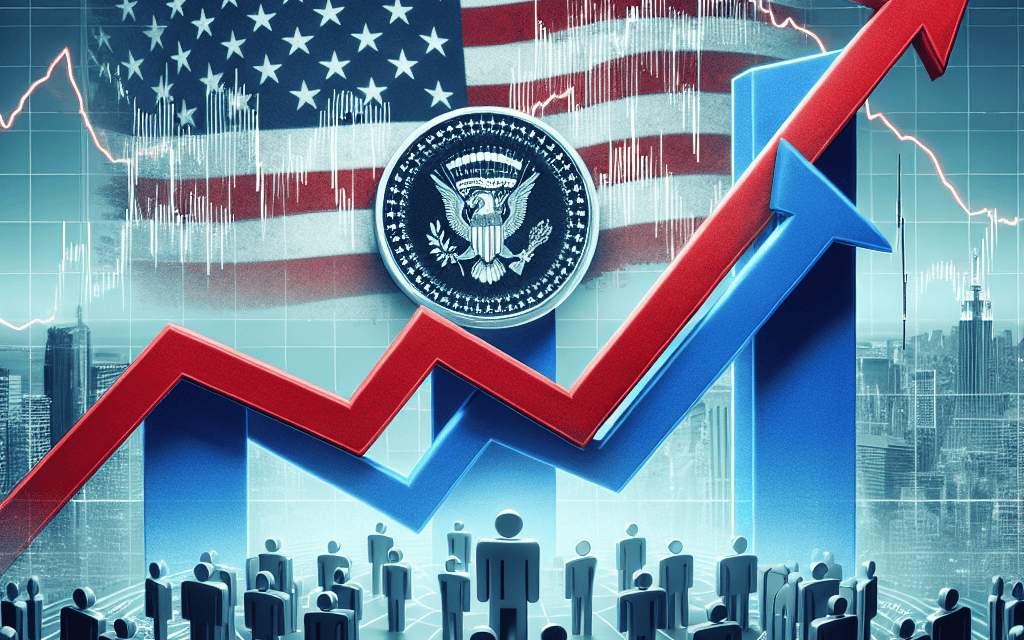“Decoding Market Moves: Insights from the Trump Stock Sentiment Indicator Pre-Election”
Introduction
The Trump Stock Market Sentiment Indicator, a tool designed to gauge investor sentiment based on the policies and rhetoric of former President Donald Trump, offers intriguing insights as the election approaches. This indicator, which reflects the market’s response to Trump’s economic strategies, trade policies, and regulatory changes, serves as a barometer for understanding how investors might react to potential shifts in political leadership. As the election nears, the indicator reveals heightened volatility and uncertainty, reflecting investor concerns over policy continuity and economic stability. By analyzing trends and fluctuations in this sentiment indicator, stakeholders can better anticipate market movements and strategize accordingly in the face of political change.
Understanding the Trump Stock Market Sentiment Indicator
The Trump Stock Market Sentiment Indicator has emerged as a fascinating tool for gauging investor sentiment in the lead-up to elections, particularly those involving former President Donald Trump. This indicator, while not officially recognized in financial circles, has gained traction among analysts and investors who seek to understand the complex interplay between political developments and market reactions. As the next election approaches, understanding this indicator becomes increasingly relevant for those looking to anticipate market movements and make informed investment decisions.
At its core, the Trump Stock Market Sentiment Indicator is based on the premise that the stock market’s performance can be influenced by the political climate, especially when it involves a polarizing figure like Donald Trump. Historically, Trump’s policies and rhetoric have had a significant impact on market sentiment, with investors reacting to his statements and policy proposals. For instance, during his presidency, Trump’s tax cuts and deregulation efforts were generally well-received by the market, leading to bullish trends. Conversely, his trade wars and unpredictable communication style often resulted in market volatility.
To comprehend the nuances of this indicator, it is essential to consider the broader context of how political events shape investor behavior. Markets are inherently forward-looking, meaning that investors make decisions based on their expectations of future events. When Trump is a central figure in the political landscape, his actions and statements can create uncertainty or optimism, which in turn affects market sentiment. This dynamic is particularly pronounced during election periods when the stakes are high, and the potential for policy shifts is significant.
Moreover, the Trump Stock Market Sentiment Indicator is not solely about Trump’s direct influence on the market. It also reflects the broader economic policies associated with his political platform. Investors often assess the likelihood of Trump’s policies being implemented and their potential impact on various sectors. For example, industries such as energy, healthcare, and technology may experience different levels of volatility based on perceived policy changes. As a result, the indicator serves as a barometer for how investors perceive the potential outcomes of an election involving Trump.
In addition to policy considerations, the indicator also captures the psychological aspect of investing. Trump’s presence in the political arena can evoke strong emotions among investors, leading to heightened market sensitivity. This emotional component can amplify market reactions, making the Trump Stock Market Sentiment Indicator a valuable tool for understanding the sentiment-driven aspects of market behavior. By analyzing patterns in market movements during key political events, investors can gain insights into how sentiment is likely to evolve as the election approaches.
As we look ahead to the upcoming election, the Trump Stock Market Sentiment Indicator offers a unique lens through which to view potential market trends. While it is not a foolproof predictor of market movements, it provides valuable context for understanding how political developments may influence investor sentiment. By considering both the policy implications and emotional responses associated with Trump’s candidacy, investors can better navigate the complexities of the market landscape. Ultimately, the indicator underscores the intricate relationship between politics and markets, highlighting the importance of staying informed and adaptable in an ever-changing environment.
Historical Trends of the Trump Stock Market Sentiment Indicator
The Trump Stock Market Sentiment Indicator, a tool designed to gauge investor sentiment based on the political climate surrounding former President Donald Trump, has become a focal point for analysts and investors alike, especially as elections approach. Historically, this indicator has provided insights into how political developments can influence market behavior, offering a unique perspective on the interplay between politics and economics. As we delve into the historical trends of this indicator, it becomes evident that its fluctuations are closely tied to key political events and the broader economic landscape.
Initially, the Trump Stock Market Sentiment Indicator gained prominence during the 2016 presidential election. At that time, the market’s reaction to Trump’s unexpected victory was marked by a significant rally, often referred to as the “Trump Bump.” This surge was driven by investor optimism regarding Trump’s pro-business policies, including tax cuts and deregulation. The indicator reflected heightened investor confidence, as market participants anticipated a favorable economic environment under the new administration. Consequently, the stock market experienced a period of robust growth, with major indices reaching record highs.
However, as Trump’s presidency progressed, the sentiment indicator began to exhibit more volatility. This was largely due to the unpredictable nature of Trump’s policy decisions and rhetoric, which often led to market uncertainty. For instance, the trade tensions between the United States and China, initiated by Trump’s imposition of tariffs, caused fluctuations in the indicator. Investors were concerned about the potential impact of a trade war on global economic growth, leading to periods of market instability. Despite these challenges, the indicator demonstrated resilience, as investors remained hopeful about the long-term benefits of Trump’s economic agenda.
As the 2020 election approached, the Trump Stock Market Sentiment Indicator once again became a critical tool for assessing market expectations. The election was characterized by heightened political polarization and uncertainty, exacerbated by the COVID-19 pandemic. During this period, the indicator reflected a mixed sentiment among investors. On one hand, there was optimism about the potential for continued economic recovery under Trump’s leadership. On the other hand, concerns about the handling of the pandemic and its economic repercussions led to caution among market participants.
In the aftermath of the 2020 election, the indicator experienced a notable shift. With the election of President Joe Biden, investor sentiment began to realign with the anticipated policy changes of the new administration. The transition of power marked a departure from the Trump era, prompting investors to reassess their strategies in light of Biden’s policy priorities, such as infrastructure spending and renewable energy investments. This shift underscored the indicator’s sensitivity to political transitions and its ability to capture the evolving market sentiment.
Looking ahead to the upcoming election, the Trump Stock Market Sentiment Indicator continues to serve as a valuable barometer for investors. As political dynamics evolve, the indicator will likely reflect the market’s response to potential candidates, policy proposals, and geopolitical developments. By analyzing historical trends, investors can gain insights into how the indicator may behave in the future, allowing them to make informed decisions in an ever-changing political and economic landscape. Ultimately, the Trump Stock Market Sentiment Indicator remains a testament to the intricate relationship between politics and market sentiment, offering a window into the complex world of investor psychology.
How the Indicator Predicts Election Outcomes
The Trump Stock Market Sentiment Indicator has emerged as a fascinating tool for gauging potential election outcomes, particularly in the context of the upcoming election. This indicator, which reflects the stock market’s response to political developments, offers insights into how investors perceive the economic implications of a potential Trump administration. As we delve into the mechanics of this indicator, it becomes evident that its predictive power lies in its ability to capture the collective sentiment of investors, who are often swayed by the economic policies and political rhetoric associated with different candidates.
To understand how the Trump Stock Market Sentiment Indicator predicts election outcomes, it is essential to consider the relationship between political events and market reactions. Historically, stock markets have been sensitive to political uncertainty, with investors adjusting their portfolios based on anticipated policy changes. In the case of the Trump administration, the market’s response has often been tied to expectations of deregulation, tax reforms, and trade policies. Consequently, fluctuations in the stock market can serve as a barometer for investor confidence in Trump’s economic agenda.
Moreover, the indicator’s predictive capability is enhanced by its ability to capture shifts in investor sentiment over time. As the election approaches, market participants closely monitor political developments, including debates, campaign speeches, and policy announcements. These events can lead to rapid changes in market sentiment, which are reflected in stock prices. For instance, a strong performance by Trump in a debate or a favorable economic policy announcement can lead to a surge in stock prices, indicating increased investor confidence in his potential re-election.
In addition to capturing immediate market reactions, the Trump Stock Market Sentiment Indicator also considers longer-term trends. By analyzing historical data, it is possible to identify patterns that may suggest how the market is likely to react to different election outcomes. For example, if the market has consistently responded positively to Trump’s policies in the past, it may indicate a higher likelihood of a favorable market reaction to his re-election. Conversely, if the market has shown volatility or negative reactions to his policies, it may suggest a more uncertain outlook.
Furthermore, the indicator’s effectiveness is not limited to predicting the outcome of the presidential election alone. It can also provide insights into congressional races, as the composition of Congress plays a crucial role in shaping the legislative agenda. A market that anticipates a Republican-controlled Congress may react differently than one expecting a Democratic majority, as each scenario carries distinct implications for policy implementation.
While the Trump Stock Market Sentiment Indicator offers valuable insights, it is important to recognize its limitations. Market sentiment is influenced by a myriad of factors, including global economic conditions, geopolitical events, and unforeseen crises. Therefore, while the indicator can provide a snapshot of investor sentiment, it should be considered alongside other economic and political analyses.
In conclusion, the Trump Stock Market Sentiment Indicator serves as a compelling tool for predicting election outcomes by capturing the collective sentiment of investors. Its ability to reflect both immediate market reactions and longer-term trends makes it a valuable resource for understanding how political developments may influence the stock market. As the election approaches, this indicator will undoubtedly continue to be closely watched by investors and analysts alike, offering a unique perspective on the intersection of politics and economics.
The Impact of Political Events on Market Sentiment

The intersection of politics and financial markets has long been a subject of interest for investors and analysts alike. As the United States approaches another pivotal election, the Trump Stock Market Sentiment Indicator has emerged as a tool for gauging market sentiment in response to political events. This indicator, which reflects the market’s perception of former President Donald Trump’s influence on economic policies and their potential impact on financial markets, offers valuable insights into how political developments can sway investor confidence and market dynamics.
Historically, political events have had a profound impact on market sentiment, often leading to increased volatility and shifts in investment strategies. The Trump Stock Market Sentiment Indicator, in particular, captures the market’s reaction to Trump’s statements, policy proposals, and public appearances. As the election draws near, this indicator becomes increasingly relevant, providing a barometer for how investors might react to the evolving political landscape. The indicator’s fluctuations can be attributed to several factors, including Trump’s stance on regulatory policies, tax reforms, and international trade agreements, all of which have significant implications for various sectors of the economy.
Moreover, the anticipation of potential policy changes can lead to preemptive market movements. For instance, if the indicator suggests a favorable market sentiment towards Trump’s economic policies, investors might increase their exposure to sectors that are likely to benefit from deregulation or tax cuts. Conversely, a negative sentiment could prompt a shift towards more defensive investment strategies, as market participants brace for potential uncertainties. This dynamic underscores the importance of understanding the broader political context and its potential ramifications on market behavior.
In addition to policy considerations, the Trump Stock Market Sentiment Indicator also reflects the market’s perception of political stability and governance. Political events, such as debates, rallies, and election outcomes, can influence investor confidence and, consequently, market performance. A stable political environment is generally perceived as conducive to economic growth, while political uncertainty can lead to risk aversion and market downturns. As such, the indicator serves as a proxy for assessing the market’s outlook on political stability and its potential impact on economic prospects.
Furthermore, the indicator’s relevance extends beyond domestic markets, as global investors closely monitor U.S. political developments. The interconnectedness of global financial markets means that political events in the United States can have ripple effects across international markets. Consequently, the Trump Stock Market Sentiment Indicator not only provides insights into domestic market sentiment but also offers a glimpse into how global investors might adjust their portfolios in response to U.S. political dynamics.
In conclusion, the Trump Stock Market Sentiment Indicator reveals the intricate relationship between political events and market sentiment, highlighting the importance of political developments in shaping investor behavior and market trends. As the election approaches, this indicator will continue to serve as a valuable tool for investors seeking to navigate the complexities of the financial markets amidst a backdrop of political uncertainty. By understanding the nuances of this indicator, investors can better position themselves to capitalize on opportunities and mitigate risks associated with the ever-evolving political landscape.
Comparing the Trump Indicator with Other Market Sentiment Tools
The Trump Stock Market Sentiment Indicator has emerged as a unique tool for gauging investor sentiment, particularly in the lead-up to elections. This indicator, which tracks market reactions to statements and policies associated with former President Donald Trump, offers insights into how political developments can influence market behavior. As we approach another election cycle, it is crucial to understand how this indicator compares with other market sentiment tools and what it reveals about investor expectations.
To begin with, the Trump Indicator is distinct in its focus on political rhetoric and policy announcements. Unlike traditional sentiment tools that rely on economic data or investor surveys, this indicator captures the immediate market response to Trump’s public statements. This real-time analysis provides a dynamic view of market sentiment, reflecting the rapid shifts in investor confidence that can occur in response to political developments. In contrast, other sentiment tools, such as the Consumer Confidence Index or the VIX, offer broader measures of market sentiment based on economic conditions or market volatility. These tools provide valuable context but may not capture the nuances of political influence as effectively as the Trump Indicator.
Moreover, the Trump Indicator’s emphasis on political events highlights the growing intersection between politics and market behavior. In recent years, investors have become increasingly attuned to the impact of political decisions on economic outcomes. This awareness has led to a heightened sensitivity to political rhetoric, making tools like the Trump Indicator particularly relevant. By focusing on the market’s reaction to specific political events, this indicator offers a targeted approach to understanding investor sentiment, complementing broader sentiment measures that may overlook these subtleties.
Furthermore, the Trump Indicator’s predictive power lies in its ability to anticipate market trends based on political developments. As we approach the upcoming election, this tool can provide valuable insights into how investors are positioning themselves in response to potential policy changes. For instance, if the market reacts positively to Trump’s statements on economic growth, it may signal investor optimism about future economic policies. Conversely, negative market reactions could indicate concerns about potential policy disruptions. By analyzing these reactions, investors can gain a clearer understanding of market expectations and adjust their strategies accordingly.
In comparison to other sentiment tools, the Trump Indicator offers a more focused lens on political influence, but it is not without limitations. Its reliance on political events means that it may not fully capture broader economic trends that also impact market sentiment. Therefore, it is essential to use this indicator in conjunction with other tools to gain a comprehensive view of market dynamics. By integrating the Trump Indicator with traditional sentiment measures, investors can develop a more nuanced understanding of the factors driving market behavior.
In conclusion, the Trump Stock Market Sentiment Indicator provides a valuable perspective on the interplay between politics and market sentiment. As we approach the election, this tool offers insights into investor expectations and potential market trends. While it is distinct in its focus on political events, it should be used alongside other sentiment tools to provide a holistic view of market dynamics. By doing so, investors can better navigate the complexities of the market and make informed decisions in the face of political uncertainty.
Investor Reactions to Election Predictions
As the United States approaches another pivotal election, investors are keenly observing various indicators to gauge potential market reactions. Among these, the so-called “Trump Stock Market Sentiment Indicator” has garnered significant attention. This informal measure, which reflects market sentiment based on former President Donald Trump’s influence and potential political resurgence, offers intriguing insights into investor behavior and expectations ahead of the election.
To understand the implications of this indicator, it is essential to consider the broader context of market sentiment and its historical relationship with political events. Traditionally, markets are sensitive to political uncertainty, as changes in administration can lead to shifts in economic policy, regulatory frameworks, and international relations. Consequently, investors often adjust their portfolios in anticipation of such changes, seeking to mitigate risks and capitalize on potential opportunities.
The Trump Stock Market Sentiment Indicator, while not an official metric, captures the market’s perception of Trump’s impact on economic policies and business environments. During his presidency, Trump’s administration was characterized by tax cuts, deregulation, and a focus on domestic manufacturing, which were generally well-received by the business community. As a result, any indication of Trump’s potential return to political prominence can influence investor sentiment, as it may signal a return to similar policies.
In the lead-up to the election, this sentiment indicator has shown fluctuations that reflect the evolving political landscape. For instance, when Trump announces rallies or gains traction in political polls, there is often a noticeable uptick in market optimism, particularly in sectors that benefited from his previous policies, such as energy, finance, and manufacturing. Conversely, when his political prospects appear to wane, there may be a corresponding dip in market confidence, as investors brace for the possibility of alternative policy directions.
Moreover, the Trump Stock Market Sentiment Indicator also highlights the broader trend of how political figures can influence market dynamics beyond their tenure in office. This phenomenon underscores the importance of understanding the interplay between politics and economics, as well as the need for investors to remain agile in their strategies. By closely monitoring political developments and their potential impact on market conditions, investors can better position themselves to navigate the uncertainties that elections inevitably bring.
In addition to the direct influence of Trump’s political activities, the sentiment indicator also reflects broader investor concerns about economic stability and growth prospects. As the global economy continues to recover from the disruptions caused by the COVID-19 pandemic, issues such as inflation, supply chain challenges, and geopolitical tensions remain at the forefront of investor considerations. In this context, the Trump Stock Market Sentiment Indicator serves as a barometer for how investors perceive the potential for policy continuity or change, and how these perceptions may affect market performance.
In conclusion, the Trump Stock Market Sentiment Indicator offers valuable insights into investor reactions to election predictions and the broader political climate. By understanding the nuances of this informal measure, investors can gain a deeper appreciation of the complex interplay between politics and market dynamics. As the election approaches, staying attuned to these signals will be crucial for navigating the uncertainties and opportunities that lie ahead.
Strategies for Investors Based on Sentiment Indicator Insights
As the United States approaches another pivotal election, investors are keenly observing various indicators to gauge potential market movements. Among these, the Trump Stock Market Sentiment Indicator has emerged as a noteworthy tool for understanding investor sentiment and its implications for market strategies. This indicator, which reflects the market’s perception of former President Donald Trump’s influence on economic policies and their potential impact on the stock market, offers valuable insights for investors seeking to navigate the complexities of election-related market volatility.
To begin with, the Trump Stock Market Sentiment Indicator is not merely a reflection of political preferences but rather a composite measure that captures the market’s expectations of policy changes and economic outcomes associated with Trump’s political presence. As such, it provides a nuanced view of how investors anticipate shifts in fiscal policies, regulatory environments, and international trade agreements. This is particularly relevant as elections often bring about uncertainty, prompting investors to reassess their portfolios in light of potential policy shifts.
In the lead-up to the election, the sentiment indicator has shown fluctuations that mirror the broader market’s apprehensions and optimism. For instance, periods of heightened positive sentiment often correlate with expectations of tax cuts or deregulation, which are perceived as favorable for business growth and profitability. Conversely, negative sentiment may arise from concerns over trade tensions or geopolitical instability, which could adversely affect market performance. By closely monitoring these sentiment trends, investors can better position themselves to capitalize on anticipated market movements.
Moreover, the Trump Stock Market Sentiment Indicator serves as a valuable tool for developing strategic investment approaches. Investors can use the insights gleaned from this indicator to adjust their asset allocations, hedge against potential risks, and identify sectors that may benefit from anticipated policy changes. For example, a surge in positive sentiment might prompt investors to increase their exposure to sectors such as energy or financials, which could benefit from deregulation or tax incentives. On the other hand, a decline in sentiment might lead investors to adopt a more defensive stance, focusing on sectors like utilities or consumer staples that tend to be more resilient during periods of uncertainty.
Furthermore, the indicator’s insights can also inform short-term trading strategies. By analyzing sentiment shifts, traders can identify potential entry and exit points for stocks that are likely to experience volatility in response to election-related developments. This approach allows traders to capitalize on short-term price movements while managing risk through informed decision-making.
In addition to guiding individual investment strategies, the Trump Stock Market Sentiment Indicator also provides a broader perspective on market dynamics. It highlights the interconnectedness of political events and economic outcomes, underscoring the importance of considering both macroeconomic factors and investor psychology when making investment decisions. This holistic view can help investors maintain a balanced approach, avoiding overreactions to short-term market fluctuations while remaining attuned to long-term trends.
In conclusion, as the election draws near, the Trump Stock Market Sentiment Indicator offers a valuable lens through which investors can assess market sentiment and develop informed strategies. By understanding the nuances of this indicator and its implications for market movements, investors can better navigate the uncertainties of the election period, positioning themselves for potential opportunities and mitigating risks. As always, a well-considered approach that incorporates both sentiment analysis and fundamental research will be key to achieving investment success in this dynamic environment.
Q&A
1. **What is the Trump Stock Market Sentiment Indicator?**
The Trump Stock Market Sentiment Indicator is a measure used to gauge investor sentiment and market expectations related to the policies and potential re-election of Donald Trump.
2. **How does the indicator work?**
The indicator typically analyzes market trends, stock performance, and investor behavior to assess how the market perceives Trump’s impact on the economy and financial markets.
3. **What does the indicator reveal about investor confidence?**
A positive reading suggests that investors are confident in Trump’s economic policies, while a negative reading indicates uncertainty or lack of confidence.
4. **How does the indicator affect market volatility?**
The indicator can influence market volatility by reflecting investor sentiment, which may lead to increased buying or selling activity based on perceived political and economic stability.
5. **What role does the indicator play in predicting election outcomes?**
While not a direct predictor of election outcomes, the indicator provides insights into how investors are positioning themselves in anticipation of potential political changes.
6. **How reliable is the indicator in forecasting market trends?**
The reliability of the indicator can vary, as it is influenced by numerous factors, including economic data, geopolitical events, and investor psychology.
7. **What are the limitations of the Trump Stock Market Sentiment Indicator?**
The indicator may not account for all variables affecting the market, such as global economic conditions, and can be subject to rapid changes in sentiment due to unforeseen events.
Conclusion
The Trump Stock Market Sentiment Indicator, which gauges investor sentiment based on market performance during Donald Trump’s presidency, suggests a complex outlook ahead of the election. Historically, strong market performance has been associated with incumbent advantage, while volatility or downturns can signal uncertainty or lack of confidence in current leadership. As the election approaches, the indicator reveals heightened market sensitivity to political developments, reflecting investor concerns over policy continuity, economic stability, and potential regulatory changes. Ultimately, the indicator underscores the market’s role as a barometer of political sentiment, highlighting the intricate interplay between economic conditions and electoral outcomes.





